Introduction
We are pleased to announce Healthier Hens, a new EA-aligned animal welfare organization. Our vision is to cost-effectively improve the well-being of millions of farmed egg-laying hens. We are investigating the potential of an intervention focused on improving the nutritional quality of layer hen feed, as recommended by the Charity Entrepreneurship (CE) research team. We are proud graduates of the CE Incubation Program’s 2021 cohort, and our initial work is supported by a $100,000 seed grant.
While impactful, the egg industry’s ongoing positive transition to cage-free systems does not address the deeply neglected issue of poor bone health in layer hens, a major welfare problem prevalent across all housing systems on commercial farms. We choose to act now and in doing so seek to achieve unprecedented counterfactual impact.
Overview
We founded Healthier Hens because we believe that given the scale of suffering that egg-laying hens endure, there is still room for improving their welfare. Recent studies suggest that the chronic pain resulting from bone fractures is so severe that it causes egg-laying hens to enter depressive states. Even more alarming, bone fractures are prevalent across all types of housing systems. Such pain places a huge amount of stress on the individual birds, prevents them from carrying out their natural behaviors, and represents a significant fraction of their total lives spent in suffering, as shown by the Welfare Footprint Project below. Many solutions, including breed selection, perch placement, and chick training, are needed to completely eradicate this welfare issue on factory farms. Our current priority is addressing the inconsistent and often suboptimal nutrient levels in commercial feeds.
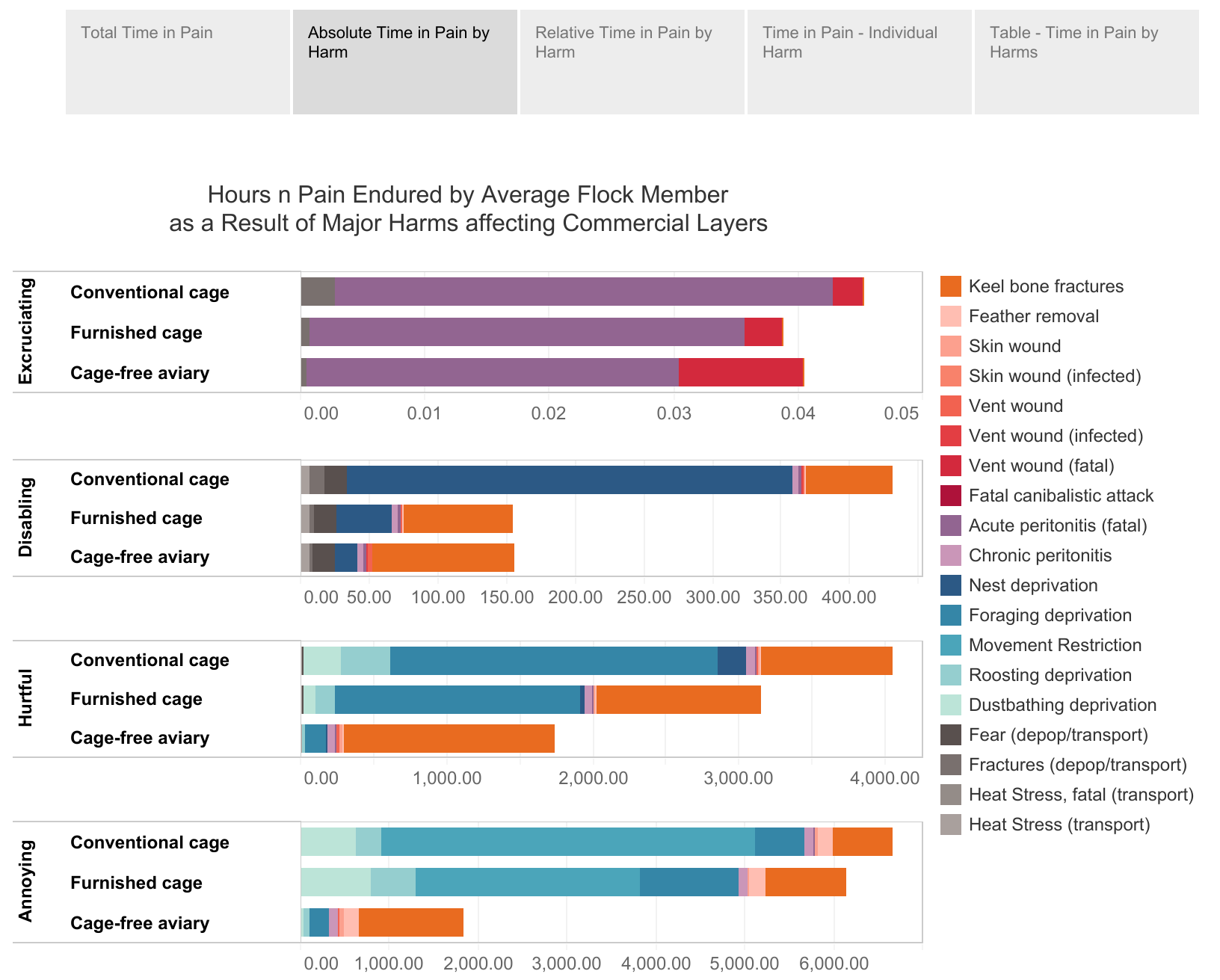
Feed fortification is the process of adding nutrients such as minerals and vitamins to feed to produce a nutritionally complete diet. The industry does apply this practice, but typically, only in order to maximize egg production, which may compromise health. Through our literature review, we found that increasing the levels of calcium, phosphorus, and vitamin D3 can help hens develop stronger, healthier bones and reduce the risk of fractures. At this time, we consider optimal levels of these nutrients in feed to be 4% calcium, 0.3% available phosphorus, and 3000 IU/kg of vitamin D3. However, it is critical for us to be sure of what benefits such levels could yield and thus we plan to run a pilot of our feed fortification intervention during the next egg production cycle (starting Jan-Feb 2022).
Currently, we are in the final process of selecting a country to work in. Each co-founder will visit one of three countries under consideration (Germany, Kenya, and the USA), identified in earlier rounds of our geographical assessment. We want to make sure we choose a country in which Healthier Hens can achieve impact. We plan to speak to local farmers and feed experts as well as engage animal nutritionists and welfare researchers to best gauge the need for and feasibility of implementation. If you know anyone with experience in these areas who may be willing to connect, please reach out to us at info@healthierhens.com. Expert opinions and advice will be invaluable in helping us best progress towards Healthier Hens.
Ultimately, our endline goal is to influence the regulation and enforcement of optimal feed nutrient levels at scale. Our vision is to cost-effectively reduce the pain and suffering of at least 100 million hens over 10 years of our organization's operations.
Our thanks go to Aaron Gertler, Antonia Personette, Charles He, Haven King-Nobles, Karolina Sarek, and Ula Zarosa for their valuable feedback on this announcement. Any remnant errors are our own - do point them out if you spot any. Thanks!
Why is layer hen feed quality an issue?
Globally, there are around 7.5 billion egg-laying hens alive at any given time. Chickens are by far the most populous farmed land animals and are generally kept in extremely low-welfare conditions. Millions of egg-laying hens needlessly suffer from painful bone fractures, with incidence rates reaching more than 85% in some modern farms. And, unfortunately, hens experience poor bone health irrespective of the type of housing system used. These hens have been selectively bred in order to maximize their egg production, which has led to an immense strain on their health. Each egg laid by a hen requires a large amount of biological input, with nutrients such as calcium, phosphorus, and vitamin D playing a critical role in shell formation. These same nutrients are also vital for bone health and skeletal development. With hens now laying more than 300 eggs per year, mineral and vitamin imbalances and deficiencies can lead to severe health issues as the nutrient demands for bones and eggs are in competition. This purposefully-bred increase in egg production, along with inconsistencies across commercial diets, is one of the reasons behind the high rates of bone fractures and osteoporosis on farms. These impairments lead to intense and long-lasting pain for egg-laying hens, poor welfare, and an increased risk for early mortality.
Our background research indicates that egg-laying hen feed standards are inadequate in several of the leading egg-producing countries. Furthermore, national feed guidelines are typically poorly enforced or non-existent, condemning hens to lives of inadequate welfare and prolonged suffering. Since feed is the primary cost in egg farming, industrial optimization likely skews towards productivity and the bottom line at the cost of animal welfare. The hens’ short lifespans lend credence to this assumption - they are typically slaughtered at around 72 weeks old, a mere fraction of their natural lifespan in non-farm captive settings. Additionally, bone deformities and fractures often go unnoticed - unsurprisingly so, as the caretaker-to-hen ratio can be as low as 1:100,000 on commercial farms. In contrast, farmers are much more sensitive towards issues where the injured birds exhibit obvious signs of illness such as lameness or “layer fatigue” that result in a drop in egg productivity.
The consumption of eggs and their products is on the rise in many countries. This, combined with rapidly growing populations in some regions, will lead to a vast increase in the number of farmed layer hens - and the total potential for their suffering if we fail to act.
How can we help layer hens?
There is robust evidence for the industry’s capacity to significantly reduce layer hens’ disease rates with feed fortification. At least ten studies to date evaluate the effects of calcium, fourteen of phosphorus, and six of vitamin D3 supplementation on hen welfare, as indicated in the CE research report. This research area has received more attention recently, with new studies coming out each year. The progressing knowledge base is well-reflected in the Nutrient Requirements of Poultry guidelines put forth by the National Research Council, a widely regarded authority on hen nutrition. As can be seen in the charts below, research has historically guided the recommended nutrient levels, with the proposed levels of calcium and vitamin D having continuously increased as new research was published between 1944 and 1994.
 | 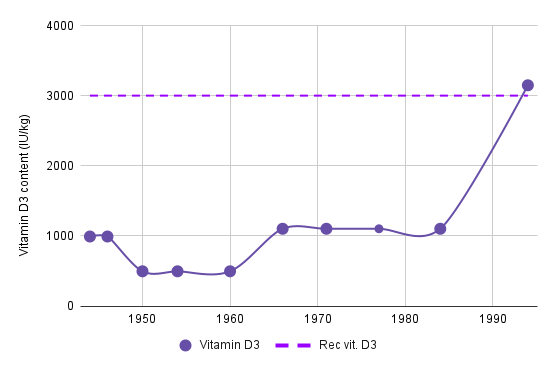 |
Our endline goal is to improve the welfare of millions of egg-laying hens. Our Plan A is to seek policy change and nutrient level regulations nationwide. However, we must first establish a presence and build relationships in our country of operations. Subsidizing the cost of additional supplements or directly providing farmers with fortified feed represents a straightforward causal chain - one that would allow us to gather real impact data on commercial farms. This would also provide us with an opportunity to assess what effects such partnerships could have on farm economics. We need to make sure that our intervention does not increase egg farming profit margins and cause a net rise in suffering in the long run. Robust on-farm data is critical to quantitatively evaluate this risk.
Farmers are constantly looking for improvements to productivity and hen health on their farms. Thus, they are likely to welcome feed fortification at a subsidized rate if we find that their feed is suboptimal and that an improvement could alleviate several issues. Provided that they would observe lower disease and mortality rates, farmers may be motivated to continue applying feed fortification even as we gradually move away from direct subsidization. Furthermore, farmers often witness temporary increases in welfare issues in their flocks when transitioning to cage-free systems. Ensuring that the hens get high-quality feed during this turbulent period could be a good way for us to collaborate with ongoing chicken welfare campaigns. Given its relatively high estimated cost-efficiency, long-term subsidization presents a viable Plan B in the case that an education + policy advocacy approach turns out not to be tractable in our country of operations. However, our endline goal as of now is still to ensure that governmental policy and regulatory change takes place, which, together with effective enforcement, would scale our implementation efforts.
We rate our intervention’s chance of success at 30%. This estimate might seem low, but it takes many uncertainties into account. Our concerns include Healthier Hens being the first organization to work on feed fortification, the difficulties associated with working with the commercial farming industry, and the varying animal welfare movement dynamics across different regions. Direct subsidization seems tractable in the beginning as it does not invoke additional costs for the farmers and has the potential to improve their image and egg quality over that of their competitors. The difficulties lie in:
- The logistical challenges of adding the supplementary nutrients to the feed. Our interviews with experts highlighted that fortification might necessitate the provision and installation of capital cost-intensive microdosing equipment on farms that produce their own feed. We are also unsure how many feed mills already have such facilities vs. buy pre-mixes of supplements and trace elements;
- Convincing farmers that they should experiment with feed fortification when the benefits to them are not immediately apparent and the additional running costs may be significant;
- Navigating the local animal NGO space and achieving synergy with ongoing cage-free campaigns.
Our theory of change (ToC)
Healthier Hens seeks to solve hen health and welfare issues exacerbated by diets that are biologically deficient in minerals and vitamins. In the beginning, we will approach this issue by ensuring that more farmers provide layer hens with nutrition optimal in calcium, phosphorus, and vitamin D. We intend to deploy feed fortification through two main strategies in our first two years of operations:
- Initial phase (pilot and Y2):
- Strategy 1 - Provide farmers with a premix of nutrients to add to their feed free of charge or a feed optimal in key nutrients at a subsidized rate.
- Strategy 2 - Collaborate with feed-producing mills and companies that are already producing and distributing feed/premixes and advise them to boost nutrients where necessary.
- Intervention scale-up:
- Plan A: Begin outreach and lobbying activities alongside the industrial partnerships and seek policy change with follow-up enforcement work.
- Plan B: Scale activities via subsidization until a favorable climate for lobbying work develops.
Strategy 1 will be applied in the initial, low-cost testing stage. It could also serve as a fallback approach later if it proves too difficult to partner with mills straight away. Meanwhile, strategy 2 is how we intend to scale our implementation after the pilot program. Later on, we will shift more and more resources towards our outreach and lobbying activities (Plan A initiation), where our work with local partners and NGOs will serve as additional levers to accelerate change. Interviews with experts have updated our expected success of a lobbying campaign - historically, NGOs have achieved lobbying successes even in politically turbulent countries, suggesting that it might be possible to collaborate with ongoing campaigns and include feed quality as a key ask. The last stage of implementation in a given country of operations would be to remain involved solely in enforcement and regulation activities.
Our holistic theory of change, represented below, explains how our intervention will lead to impact. To start, we have begun key activities such as conducting further research on our intervention and target country of implementation, establishing partnerships with farmers and feed mills to promote feed fortification, and engaging government and local animal NGOs with our intervention. Through these activities, we intend to secure partnerships with the target number of farmers to pilot our intervention and with feed mills for feed fortification, as well as promote policy advocacy among government stakeholders in achieving national optimal feed standards. These activities will help us achieve our goals of improved layer hen welfare on the farms that we reach and provide a good platform for the scale-up and sustainability of the intervention.
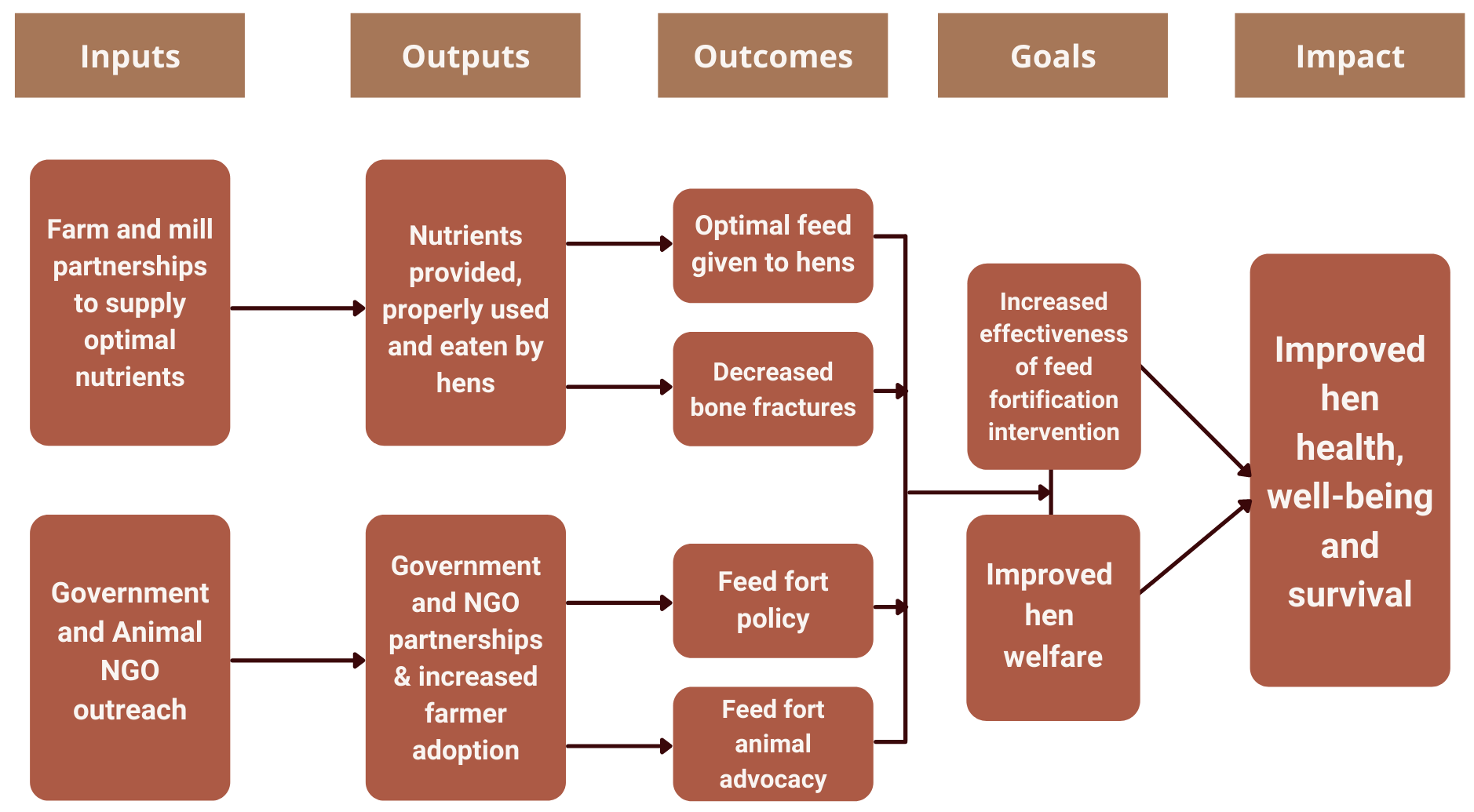
Theoretical cost-effectiveness estimates
The table below shows an overview of two cost-effectiveness analysis (CEA) models that we have developed. The first row shows yearly figures that we aspire to reach by the end of Y2. At that point, we still plan to focus mainly on building relationships and getting several producers on board with the intervention via supplement subsidization. The second row indicates our cumulative ambitions for impact after 10 years of operation. This includes a significant fraction of resources allocated to producer and policy lobbying campaigns.

You can find more details about the factors we considered for both models in our guesstimates: yearly and 10 years of charity. Please feel free to contact us if you have any questions or concerns regarding these models - we will be more than happy to discuss, explain our methodology, share more information, and take your feedback into consideration.
Country selection process
Our country selection process has been our main project so far. We have conducted three rounds of consideration that have narrowed our options from 51 countries to three (Germany, Kenya, and the United States). The three countries chosen for our final round of research are still being considered because we remain uncertain about some of the data gathered. For instance, though our initial data from the US and Germany may show high-quality feed, we were not able to find data from top manufacturers or fully integrated farms as that information is not available online. Our final round of consideration will involve in-person visits where we will check key data points via activities such as testing feed composition, interviewing farmers to gauge bone fracture incidences, and speaking with farmed animal nutritionists to help us answer questions from our research, e.g., about the current practices regarding feed phases and particle size. We will then update our country reports with the information gathered and make an official selection along with advice from our advisory board. An overview of the different steps is provided below. Alternatively, please see our complete process for each stage of research and consideration HERE
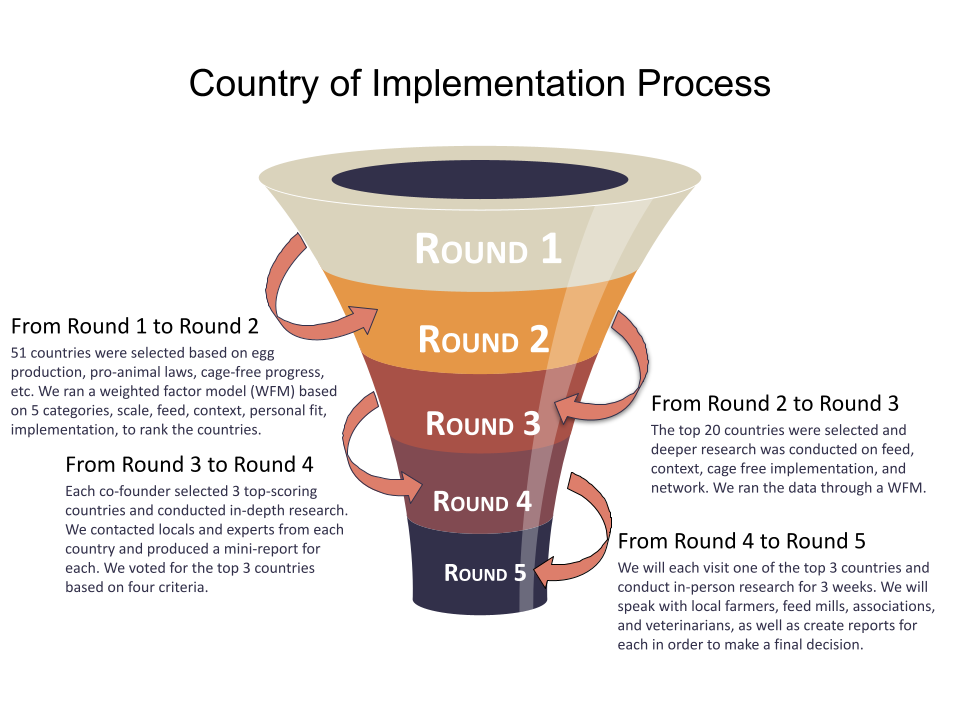
Our short-term plans
We will strive to achieve the following Year 1 goals to ensure we are on the right track to positive impact:
- Piloting: Choose a country of operations and initiate a proof-of-concept pilot program with 4 farms; explore and evaluate 3 alternative intervention models (i.e., feed production, collaboration with mills, subsidizing the purchase of supplements) by conducting in-country research (expert interviews, data gathering, etc.) and creating CEAs for each.
- Fundraising: Secure funds for Year 1 and Year 2 (up to $500k, incl. $100k CE seed grant).
- Monitoring & Evaluation (M&E): Measure and analyze preliminary data according to a predefined M&E concept, refine ToC and M&E concepts after the first phase of our pilot program.
- Organizational development: Found an organization via fiscal sponsorship, form legal & advisory boards, hire 3 employees (1x full-time, 2x interns), establish working processes & systems.
- Outreach: Establish a network of relevant stakeholder groups (at least: experts & mentors, other NGOs in the country of operations, suppliers, policymakers, and EA community (via 4 EA Forum posts and discussion)).
- Partners: Agree with 4 farms for pilot, create a list with potential partnerships for Year 2 collaboration.
- Community: Join at least 1 national-level association and/or movement in the country of operations.
- Knowledge: Give 3 presentations on feed fortification or hen welfare at international conferences.
- Meta: Achieve at least 80% of our goals.
Pre-mortem analysis
When planning, we try to anticipate as many pitfalls that may prevent our charity from reaching its desired impact as possible. We have identified a few scenarios and proposed mitigation approaches. See our main possible concerns below:
- Farmers and feed producers are reluctant to change
- This may be an issue especially in developed countries that assume they are already carrying out best practices. One entry point we will attempt is to provide free feed quality testing to farmers. If successful, this would allow us to show them whether their feed is low quality without any cost to them. By providing this hard data, farmers should be more willing to listen to our pitch about feed fortification. Similarly, with feed producers, we will conduct a market analysis to demonstrate that high-quality feed can be competitive in the marketplace. We are aware that many may ignore a new NGO, but hopefully, with data we can initiate a conversation. We also plan to network with as many associations as possible as we understand that a personal connection goes a long way in this industry.
- Experts disagree with our data and intervention.
- After the completion of our pilot, we will disseminate our data and final report to experts to gain their insight. We will do this in various ways, from sharing our report online via our website or an emailed PDF to holding webinar sessions with key stakeholders. If experts disagree with our findings, we will identify where and why these opinions were generated. We will gather information, feedback, and counter-arguments and weigh the data according to level of expertise, type of expertise (e.g., domain, specialist, or broad), if any evidence was provided for their counterargument, and if there are any conflicts of interest. We will evaluate and find if there is an expert consensus, and if so, act accordingly - potentially pivoting. We will place all findings on our transparency page.
- Desk research does not align with real data.
- If we start our pilot and notice that increased feed nutrient levels do not lead to the desired impact due to feed standards being close to or optimal across the country, or any other confounding factor, we will consider pivoting to another promising welfare intervention. We have found studies indicating that water contamination, lack of specific amino acids, and certain chick rearing practices, for instance, may also hinder the welfare of egg-laying hens, so we would choose the most promising option that the available data points to and conduct further research.
- Potential negative flow-through effects on the animal movement
- Campaigns such as transitioning to cage-free systems and the Better Chicken Commitment (BCC) for broiler chickens are extremely important and we do not want to reduce their chances of success. We plan to coordinate with the animal NGOs leading those campaigns in our country of implementation to make sure that our intervention is compatible with the impact they seek. Furthermore, we want to support cost-effective ongoing campaigns and collaborate with active NGOs towards healthier hens. We are also aware that our intervention may appear to support the industry in a way that might make factory farming more profitable. This is at the top of our mind and we are taking steps to address this issue. For instance, by conducting a literature review and pilot we can see if feed fortification does lead to higher egg production in real farming settings. Additionally, our endline goal of policy change with enforcement would drive up the cost of feed, already the highest-running expense farmers face, in order for them to meet welfare standards. This cost increase could potentially mitigate the issue of increased production.
Naturally, we have identified many more concerns and potential pitfalls that we will remain aware of. However, they are more technical and very specific to feed fortification, and thus beyond the scope of this introductory post. We invite anyone who is interested in digging deeper to reach out to us via email at info@healthierhens.com where we can arrange a call for an in-person discussion.
Get to know the team
We are a co-founder team of 3 with diverse work experiences and a common passion for advancement in the field of animal welfare. We tested our compatibility and formed the Healthier Hens team while taking part in the 2021 cohort of CE’s incubation program. Meet our co-founders:
 | Kikiope Oluwarore (DVM, M.Sc.) is a veterinarian with 10 years of experience in providing animal health services, animal welfare programming, and nonprofit management. She is based in Nigeria and has both national and continental experience. As the Head of Field Operations, she will lead field operations, logistics, communications, and field-based stakeholder engagement. |
 | Lukas Jasiunas (Ph.D.) is a London (UK)/Nicosia (Cyprus)-based engineer and researcher by trade and an active member of the effective animal advocacy movement in several European countries. As the Head of Research, he will be responsible for coordinating all of the organization’s research activities and will also share communication, engagement, and fundraising responsibilities. |
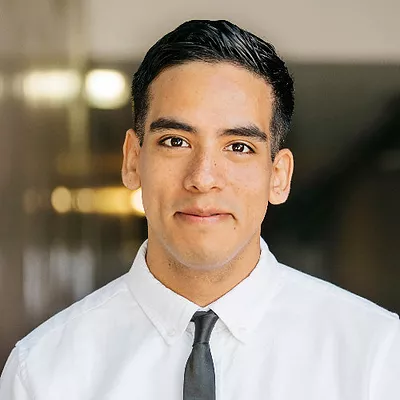 | Isaac Esparza hails from the for-profit world in Los Angeles, USA, and brings years of experience in operations, management, and logistics. As the Head of Logistics, he will establish and lead the headquarters operations systems, including taking on responsibility for financial and legal oversight, human resources and recruiting, and networking with global stakeholders. |
Where can you meet us?
We would love to meet you and discuss our work and plans, as well as answer (at the very least try!) any questions that you might have. Below is a list of recent and upcoming events where you could meet us:
- Kiki will attend EA Global on the 29-31st of October, 2021, in London, United Kingdom. You can meet her at the Effective Animal Advocacy discussion, Farmed Animal Welfare speed meetings, or during the Animal Advocacy Careers workshop. Isaac and Lukas will take part virtually.
- Kiki will attend Africa Animal Welfare Conference (AAWC) on the 1-3rd of November, 2021, virtually.
- Lukas will be present at EAGxPrague on the 3-5th of December, 2021, in Prague, Czech Republic.
- Isaac plans to attend the Lead for Farmed Animals conference on the 23-25th of March, 2022, in Newport Beach, USA.
How can you help?
There are many ways that readers passionate about animal welfare can help Healthier Hens. And we sure could use the help! Please reach out to us at info@healthierhens.com if you:
- are an animal advocate eager to help;
- are based in Germany, Kenya, USA, or have contacts there;
- know people with experience in the egg, poultry, or feed production industries;
- know a farmed animal veterinarian, nutritionist, or welfare researcher;
- are willing to donate to our cause or would like to support us via mentorship;
- have any concerns regarding something you have read here.
Otherwise, feel free to sign up for our newsletter or check out our website at healthierhens.com to get our updates and see how we do.
Acknowledgements
We express our great gratitude for the support we have received from our peers, colleagues, and CE mentors thus far. All of their inputs were vital in our starting-up phase. And we are not the only new EA organization that the CE incubatees of 2021 have founded - make sure to check out the official presentation of the 2021 cohort.

Excited about this organization and to see the good work you three will do!
Very excited about this intervention (not only because I work for CE :))! I feel like combining this with cage-free, could give really great results, although it is challenging for sure. But yeah, cost-effectiveness looks pretty amazing if you pull this off, so I wish you really really well!
Can you post a summary/link to this article from the Healthier Hens LinkedIn account? I can share that more easily with EAs in Kenya. For example, there are a group of EAs in Kenya who are in the process of launching EA Nairobi
Thanks!
Done, thanks so much for sharing --alex--!